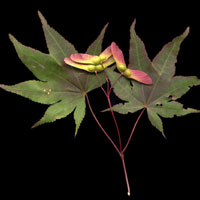Join us for conversations that inspire, recognize, and encourage innovation and best practices in the education profession.
Available on Apple Podcasts, Spotify, Google Podcasts, and more.
During this session, you will have an opportunity to build understandings to help you:

Japanese Maple leaves.
Image courtesy Len Gittleman.
Our Earth hosts an astonishing diversity of life forms. We can find plants, animals, and other types of organisms in almost every habitat that we encounter. In Session 1, characteristics shared by all life forms were introduced as features that unify the living world. Session 2 focuses on how life’s diversity arises from variation on these same unifying features. A closer look at cells, in particular, introduces fundamental differences among life forms that have become one basis for biological classification.
How do we answer the question: “What is it?” Just what makes a plant a plant, or an animal an animal? Dr. Sally Shuler, representing Science and Technology for Children (STC), highlights questions like these as she introduces us to activities in the Organisms unit. Research on children’s ideas is substantiated in the Science Studio where second and third graders give us insight into their definitions of plants and animals, as well as their awareness of other life forms.
Stephanie Selznick’s first graders in Dorchester, Massachusetts, use Venn diagrams to determine how plants and animals are alike and different. Their early ideas are based on observations of class terrariums and aquariums, where they’ve observed these life forms over time.
Dr. Paul Williams returns to share what’s going on in Bottle Biology–an ongoing Web-based activity designed to apply session topics and to serve as a K-6 resource as well. We hear from Dr. Colleen Cavanaugh as she takes us to the deepest parts of the ocean to introduce us to her favorite group of living things: life forms that aren’t classified as plants OR animals. Finally, we see how a system for biological classification is used for classifying living things into broad groups.